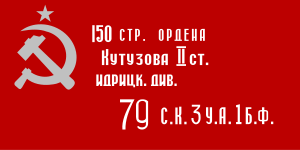Victory Banner (Soviet Union)
Appearance
This article has not been added to any content categories. Please help out by adding categories to it so that it can be listed with similar articles, in addition to a stub category. |
Victory Banner (Russian: Знамя Победы, Znamya Pobedy) can refer to three things:
- The banner that was raised by Red Army soldiers on the Reichstag in Berlin, in 1945. The Cyrillic inscription reads: "150th Rifle, Order of Kutuzov 2nd class, 'Idritskaya' Division, 79th Rifle Corps, 3rd Shock Army, 1st Byelorussian Front." This flag is not the first to be hoisted on the Reichstag, but is the first (and the only surviving) of the 'official' flags, explicitly prepared for that purpose, to be raised there.
- The variation of the Soviet flag, without the hammer and sickle, to which president Boris Yeltsin gave a status similar to that of the national flag, on April 5, 1996. President Vladimir Putin also adopted the Victory Banner as the official flag of the Russian Army. This flag was named after the flag raised on the Reichstag, but it is also called Victory Flag.
- The Victory Banner is one of the Ashtamangala, or Eight Auspicious Symbols.


